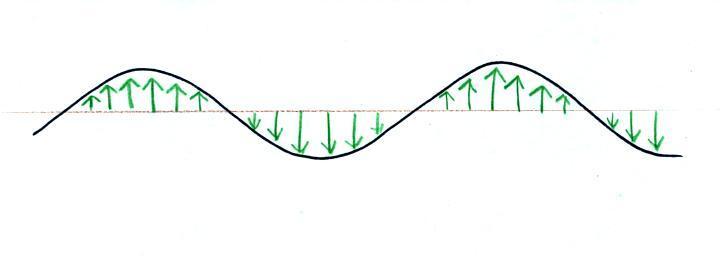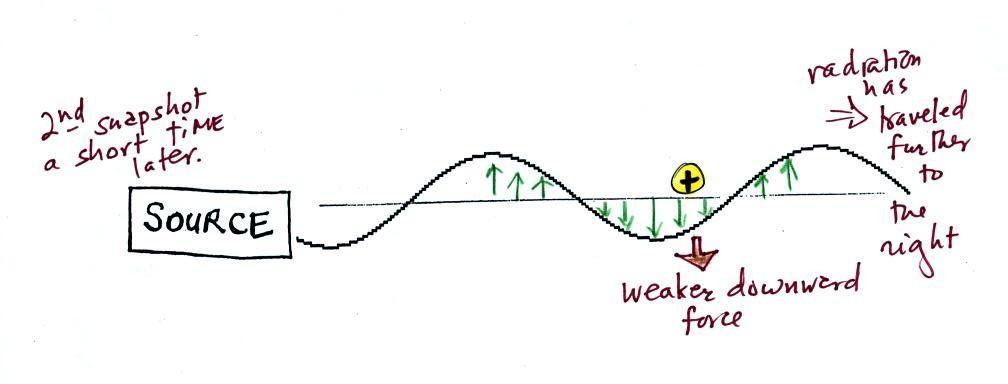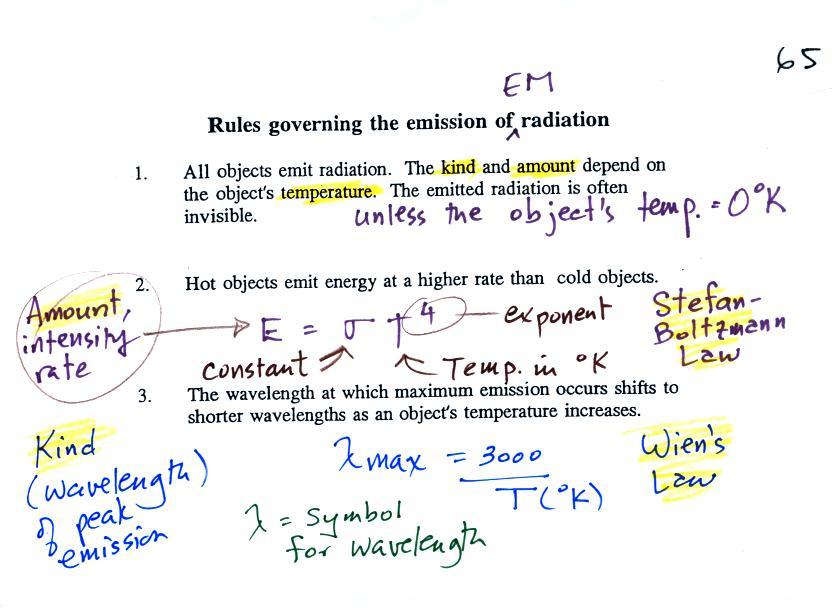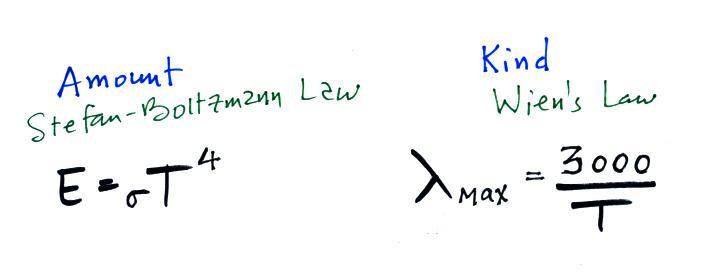Tuesday Oct. 15, 2013
Amy Winehouse "Will You Still
Love Me Tomorrow", Duffy "Lovestruck",
Adele "Set
Fire to the Rain", Elisa "Rock Your Soul"
The Upper
Level Chart Optional Assignment was collected today.
I'll have those graded in time to return before the quiz on
Thursday. If you miss 3pts or less on this assignment a Green Card will be waiting for
you before the quiz on Thursday.
The 1S1P Surface Weather Map
Analysis assignment was returned today. You will not
need to be able locate fronts like you did for this assignment on
this week's quiz.
No questions either from the last two topics on the Quiz #2 Study Guide.
You can attend a total of 3 reviews this week to prepare for the
quiz. See the Quiz #2 Study Guide for times and locations.
Experiment #3 materials should be
available for pickup before the quiz on Thursday.
Even though we were on a very tight time schedule, I took a few
minutes to show you one of my favorite graphics. It is a
page from National Geographic Magazine that lists some of the limits
of human survival. I can't just scan the original and
add it to the notes without violating copyright laws. But if
you click on the link above you'll find all of the same
information online in the form of a quiz.
At last, It's
time to tackle electromagnetic (EM) radiation
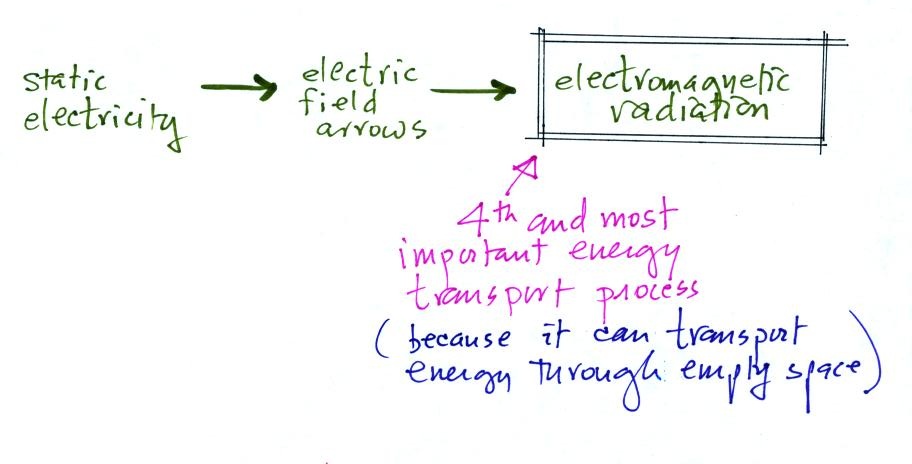
First we need to review a
couple of rules concerning static electricity and
learn something about electric
field arrows. The static electricity rules are
found at the top of p. 59 in the photocopied ClassNotes
Two electrical charges with the same polarity push each other
apart. Opposite charges are attracted to each other.
Now the concept that we will be using,
electric field arrows. Electric field arrows (or just
the E field) show you the direction and give you an idea of
the strength of the electrical force that would be exerted
on a positive charge located at that point.

In this figure (p. 59 in
the ClassNotes) a positive charge has been placed at 3
locations around a center charge. The electric field
arrow shows the direction of the force that would be
exerted on each of the charges. The force arrow is
shown in blue. The forces range from weak to strong
depending on the distance between the two charges. Once
the electric field arrows are drawn and in place you
really don't need to know there is a positive charge in
the center of the picture. The electric field arrows
tell you everything you need to know about what would
happen to a positive charge placed anywhere in the
picture.
The E field arrows tell you what will happen to a + charge. but you
can also use the arrows to determine what will happen to a
- charge
also.
For a negative charge the force will point in a direction
opposite the E field arrow.
Here are a couple of questions to test your understanding, neither of these questions was shown in
class.

What is the direction of
the electric field arrow at Point X halfway between a +
and a - charge (this question also appears on the Quiz #2
Study Guide).
The second question has two parts. First you need to
determine what polarity of charge must be on ground to
cause the charges in the figure below to move as they are
doing. Then what direction does the electric field
arrow point at a location just above the ground where the
two charges are found.

You'll find the answers to both questions
at the end of today's notes.
Now we'll use what we know about electric
fields to start to understand electromagnetic radiation.
An electric field arrow
shows the
direction and
gives an
idea of the strength
of the
electrical force
that would
be exerted on a positive charge
You'll find most of the following on p. 60 in the photocopied
ClassNotes.
We imagine turning on a source of EM radiation and then a very
short time later we take a snapshot. In that time the EM
radiation has traveled to the right (at the speed of
light). The EM radiation is a wavy pattern of electric and
magnetic field arrows. We'll ignore the
magnetic field lines. The E field lines sometimes point
up, sometimes down. The pattern of electric field arrows
repeats itself.
Textbooks often represent EM
radiation with a wavy line like shown above. They don't
usually explain what the wavy line represents.
The wavy line just connects the tips of a bunch of electric
field arrows.
Th picture above was taken a
short time after the first snapshot after the radiation had
traveled a little further to the right. The EM radiation
now exerts a somewhat weaker downward force on the + charge.
A 3rd snapshot taken a short
time later. The +
charge is now being pushed upward again.
A movie of the + charge,
rather than just a series of snapshots, would show the charge
bobbing up and down much like a swimmer in the ocean would do as
waves passed by.
The wavy pattern used to depict
EM radiation can be described spatially (what you would see in a
snapshot) in terms of its wavelength, the distance between
identical points on the pattern.
Or you can describe the radiation temporally using the
frequency of oscillation (number of up and down cycles completed
by an oscillating charge per second). By temporally we mean
you look at one particular fixed point and look at how things
change with time.

EM radiation can be created when
you cause a charge to move up and down. If you move
a charge up and down slowly (upper left in the figure above) you
would produce long wavelength radiation that would propagate out
to the right at the speed of light. If you move the charge
up and down more rapidly you produce short wavelength radiation
that propagates at the same speed.
Once the EM radiation encounters the charges at the right
side of the figure above the EM radiation causes those charges
to oscillate up and down. In the case of the long
wavelength radiation the charge at right oscillates
slowly. This is low frequency and low energy motion.
The short wavelength causes the charge at right to oscillate
more rapidly - high frequency and high energy.
These three characteristics: long wavelength / low frequency
/ low energy go together. So do short wavelength / high
frequency / high energy. Note that the two different types
of radiation both propagate at the same speed.
The
following figure illustrates how energy can be transported
from one place to another (even through empty space) in the
form of electromagnetic (EM) radiation. This figure wasn't shown in class.

You add energy when you cause an
electrical charge to move up and down and create the EM
radiation (top left).
In the middle figure, the EM
radiation that is produced then travels out to the right (it
could be through empty space or through something like the
atmosphere).
Once the EM radiation encounters an electrical charge at
another location (bottom right), the energy reappears as the
radiation causes the charge to move. Energy has been
transported from left to right.
This is really just a partial list of some of the different
types of EM radiation. In the top list, shortwave length and
high energy forms of EM radiation are on the left (gamma rays and
X-rays for example). Microwaves and radiowaves are longer
wavelength, lower energy forms of EM radiation.
We will mostly be concerned with just ultraviolet light (UV),
visible light (VIS), and infrared light (IR). Note the
micrometer (millionths of a meter) units used for wavelength for
these kinds of light. The visible portion of the spectrum falls between
0.4 and 0.7 micrometers. UV and IR light are both
invisible. All of the vivid colors shown above are just EM
radiation with slightly different wavelengths. When you see
all of these colors mixed together, you see white light.
We spent most of the rest of the
class learning about some rules governing the emission of
electromagnetic radiation. Here they are:
1.
Everything
warmer than 0 K will emit EM radiation. Everything in the
classroom: the people, the furniture, the walls and the floor,
even the air, are emitting EM radiation. Often this
radiation will be invisible so that we can't see it and weak
enough that we can't feel it (or perhaps because it is always
there we've grown accustomed to it and ignore it). Both
the amount and kind (wavelength) of the emitted radiation depend
on the object's temperature. In the classroom most
everything has a temperature of around 300 K and we will see
that means everything is emitting infrared (IR) radiation with a
wavelength of about 10µm.
2.
The second
rule allows you to determine the amount of EM radiation (radiant
energy) an object will emit. Don't worry about the units
(though they're given in the figure below), you can think of
this as amount, or rate, or intensity. Don't worry about σ (the Greek character rho) either, it is just a
constant. The amount depends on
temperature to the fourth power. If the temperature of an
object doubles the amount of energy emitted will increase by a
factor of 2 to the 4th power (that's 2 x 2 x 2 x 2 = 16).
A hot object just doesn't emit a little more energy than a cold
object it emits a lot more energy than a cold object. This
is illustrated in the following figure:

The cool object is emitting 2
arrows worth of energy. This could be the earth at 300
K. The warmer object is 2 times warmer, the earth heated
to 600 K. The earth then would emit 32 arrows (16 times
more energy).
The earth has a temperature of 300 K. The sun is 20
times hotter (6000 K). Every square foot of the sun's
surface will emit 204 (160,000)
times more energy per second than a square foot of the
earth's surface.
3.
The third
rule tells you something about the kind of radiation emitted by
an object. We will see that objects usually emit radiation
at many different wavelengths but not in equal amounts.
Objects emit more of one particular wavelength than any of the
others. This is called λmax
("lambda max", lambda is the Greek character used to represent
wavelength) and is the wavelength of maximum emission. The
third rule allows you to calculate λmax.
The tendency for warm objects to emit radiation at shorter
wavelengths is shown below.

The cool object is probably
emitting infrared light (that would be the case for the earth at
300 K) so the 2 arrows of energy are colored red. The
warmer object will also emit IR light but also shorter
wavelengths such as yellow, green, blue, and violet (maybe even
some UV if it's
hot enough). Remember when
you start mixing different colors of visible light you get
something that starts to look white.
The graphs at the bottom of p. 65 in the photocopied
ClassNotes also help
to illustrate and explain the Stefan-Boltzmann law
and Wien's laws. We're really beating this topic to death
and we're not done yet.
1.
Notice first
that both and warm and the cold objects emit radiation over a
range of wavelengths (the curves above are like quiz scores, not
everyone gets the same score, there is a distribution of
grades). The warm object emits all the wavelengths the
cooler object does plus lots of additional shorter wavelengths.
2.
The peak of
each curve is λmax. Note
that
λmax has shifted
toward shorter wavelengths for the warmer object. This is
Wien's law in action. The warmer object is emitting lots
of types of short wavelength radiation that the colder object
doesn't emit.
3.
The area
under the warm object curve is much bigger than the area under
the cold object curve. The area under the curve is a
measure of the total radiant energy emitted by the object.
This illustrates the fact that the warmer object emits a lot
more radiant energy than the colder object.
And next a demonstration of the Stefan-Boltzmann and Wien's
Laws. It consisted of an ordinary 200 W tungsten bulb is
connected to a dimmer switch (see p. 66 in the photocopied
ClassNotes). We'll be looking at the EM radiation emitted by
the bulb filament.
The graph at the bottom of p. 66 has been split up into 3
parts and redrawn for improved clarity.

We start with the bulb turned off (Setting 0). The
filament will be at room temperature which we will assume is
around 300 K (remember that is a reasonable and easy to remember
value for the average temperature of the earth's surface).
The bulb will be emitting radiation, it's shown on the top graph
above. The radiation is very weak so we can't feel
it. The wavelength of peak emission is 10
micrometers which is long wavelength, far IR
radiation so we can't see it.
Next we use the dimmer switch to just barely turn the bulb on
(the temperature of the filament is now about 900 K). The
bulb wasn't very bright at all and had an orange color.
This is curve 1, the middle figure. Note the far left end
of the emission curve has moved left of the 0.7 micrometer mark
- into the visible portion of the spectrum. That is what
you were able to see, just the small fraction of the radiation
emitted by the bulb that is visible light (but just long
wavelength red and orange light). Most of the radiation
emitted by the bulb is to the right of the 0.7 micrometer mark
and is invisible IR radiation (it is strong enough now that you
could feel it if you put your hand next to the bulb).
Finally we turn on the bulb completely (it was a 200 Watt
bulb so it got pretty bright). The filament temperature is
now about 3000K. The bulb is emitting a lot more visible
light, all the colors, though not all in equal amounts.
The mixture of the colors produces a "warm white" light.
It is warm because it is a mixture that contains a lot more red,
orange, and yellow than blue, green, and violet light. It
is interesting that most of the radiation emitted by the bulb is
still in the IR portion of the spectrum (lambda max is 1
micrometer). This is invisible light. A tungsten
bulb like this is not especially efficient, at least not as a
source of visible light.
You were able to use one of the diffraction gratings handed
out in class to separate the white light produced by the bulb
into its separate colors.
When you looked at the bright white bulb filament through one
of the diffraction gratings the colors were smeared out to the
right and left as shown at left below.
Some of the gratings handed out in class behaved a little
differently and spread out the colors horizontally, vertically,
and diagonally (right sketch above)
Here are the rules for the amount and kind (wavelength of peak
emission) of radiation emitted by an object.
Let's look at the light emitted by the sun and the earth.
The curve on the left is for the sun. We have used Wien's
law and a temperature of 6000 K to calculate λmax
and got 0.5 micrometers. This is green light; the sun emits
more green light than any other kind of light. The sun
doesn't appear green because it is also emitting lesser amounts of
violet, blue, yellow, orange, and red - together this mix of
colors appears white (it's a cooler white than emitted by a
tungsten bulb). 44% of the radiation emitted by the sun is
visible light, Very nearly half of sunlight (49%) is IR
light (37% near IR + 12% far IR). 7% of sunlight is
ultraviolet light. More than half of the light emitted by
the sun (the IR and UV light) is invisible.
100% of the light emitted by the earth (temperature = 300 K) is
invisible IR light. The wavelength of peak emission for the
earth is 10 micrometers.
Because the sun (surface of the sun) is 20 times hotter
than the earth the sun's surface emits energy at a much higher
rate than the earth (160,000 times higher). Note
the vertical scale on the earth curve is different than on the sun
graph. If both the earth and sun were plotted with the same
vertical scale, the earth curve would be too small to be seen.
Here are the answers to the two
electric field questions embedded earlier in the notes.
#1
To answer the first question we imagine placing a + charge at
Point X.
The center charge will be repelled by the charge on the left
and attracted to the charge on the right. The center charge
would move toward the right.
The electric field arrow shows the direction of the force on
the center charge. The electric field arrow should point
toward the right.
#2
The ground can be either negatively or positively
charged. If the ground were negatively charged the positive
charge would be attracted to the ground and the
negative charge repelled and pushed upward. That's not
what is happening. So the ground must be positively charged.
The positive charge is creating the force that causes the
positive charge to move upward. So that too must be
direction that the electric field arrow is pointing.









